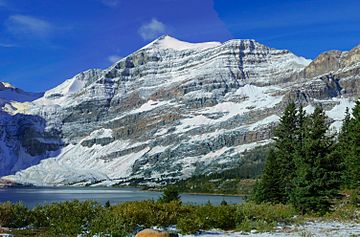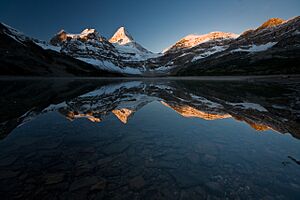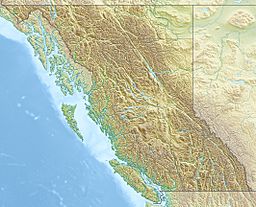Wedgwood Peak facts for kids
Quick facts for kids Wedgwood Peak |
|
|---|---|

Wedgwood Peak
|
|
| Highest point | |
| Elevation | 3,024 m (9,921 ft) |
| Prominence | 214 m (702 ft) |
| Parent peak | Mount Assiniboine (3616 m) |
| Geography | |
| Location | British Columbia, Canada |
| Parent range | Canadian Rockies |
| Topo map | NTS 82J13 |
| Geology | |
| Age of rock | Cambrian |
| Type of rock | sedimentary rock |
| Climbing | |
| First ascent | 1910 T.G. Longstaff, Katherine Longstaff, Rudolph Aemmer |
Wedgwood Peak is a tall mountain in the Canadian Rockies. It stands 3,024 meters (about 9,921 feet) high! You can find it in Mount Assiniboine Provincial Park, in British Columbia, Canada. It's not far from an even taller mountain called Mount Assiniboine, which is just 2 kilometers (1.2 miles) south. Wedgwood Peak is also near Lake Magog and the Sunburst Peaks.
How Wedgwood Peak Got Its Name
The first people to climb Wedgwood Peak were Katherine Longstaff and her brother, Dr. Tom George Longstaff. They reached the top in 1910 with their guide, Rudolph Aemmer.
The mountain was named in 1918 by Katherine Longstaff Wedgwood. She named it after her husband, Arthur Felix Wedgwood. Sadly, he was killed in World War I. Arthur Felix Wedgwood was also a descendant of Josiah Wedgwood, who was famous for his pottery.
At first, the mountain was called Mount Wedgwood in 1924. But on March 31, 1966, its official name became Wedgwood Peak. This name was approved by the Geographical Names Board of Canada.
What Wedgwood Peak Is Made Of
Wedgwood Peak is made of a type of rock called sedimentary rock. This rock formed a very long time ago, during the Cambrian period. That was about 541 to 485 million years ago!
This sedimentary rock was created in shallow seas. Over millions of years, it was pushed up and over younger rock. This happened during a big event called the Laramide orogeny. This event helped create many of the mountains we see today.
Weather at Wedgwood Peak
Wedgwood Peak has a subarctic climate. This means it has very cold and snowy winters. The summers are usually mild. Temperatures can drop below −20 °C (or −4 °F). With the wind, it can feel even colder, sometimes below −30 °C (or −22 °F).
Water from rain and melting snow on Wedgwood Peak flows in two main directions. Some water drains west into Wedgwood Creek, which then joins the Mitchell River. Other water flows east into Lake Magog.




